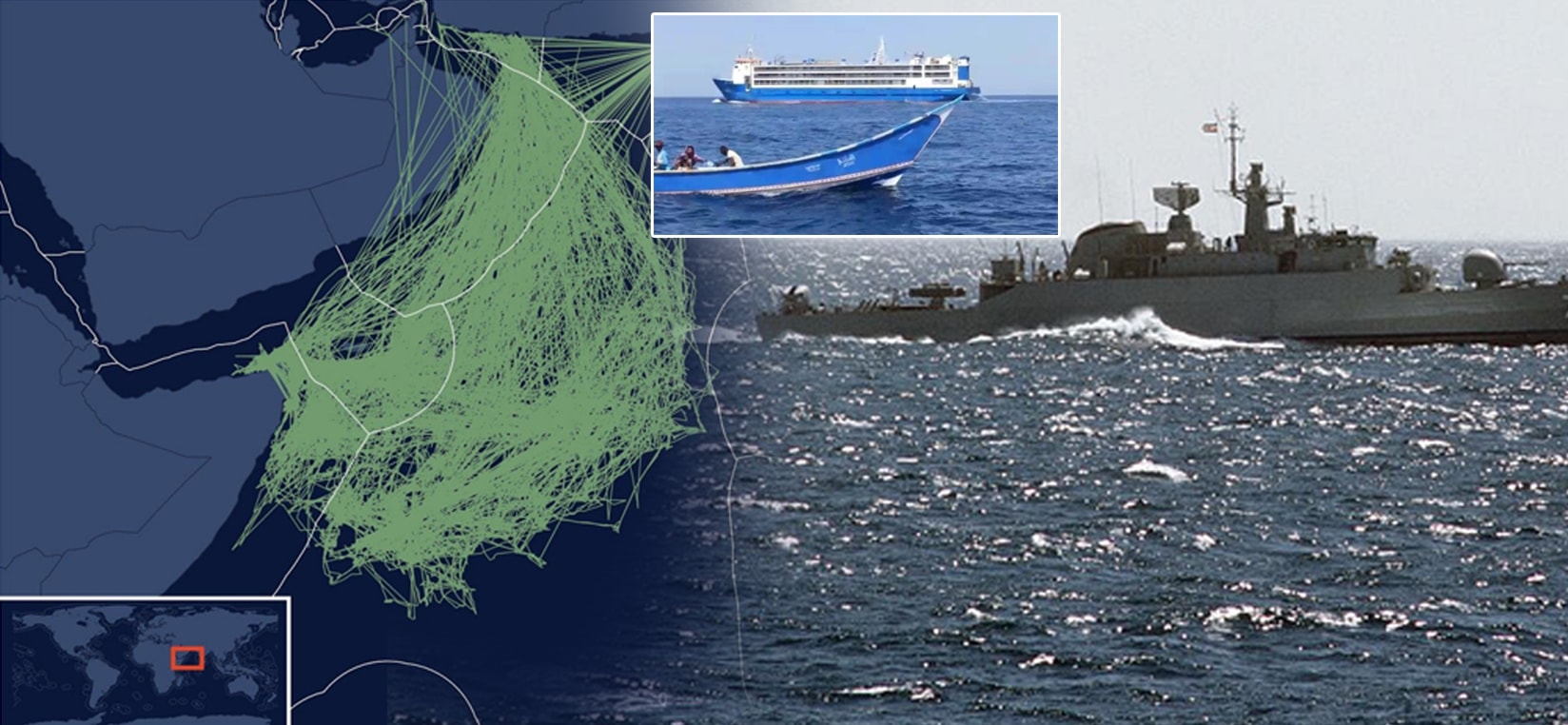
Foreign ships practicing illegal fishing in South Yemen’s territorial waters (SPA+ a photo obtained by “South24 Center” from local fishermen and data gathered from Global Fishing Watch)
Last updated on: 17-02-2023 at 6 AM Aden Time

Raad Alrimi (South24)
South Yemen has a large coastline with a length of 1689 km. It extends from the southernmost borders in Al-Mahra governorate near Oman to the east, to Bab Al-Mandab, Mayoun Island to the west, and around the Socotra archipelago to the south. [1]
The marine area, which is located between the coasts of Aden, Lahj, Abyan, Shabwa, Hadramout, Al-Mahra and Socotra, is considered South Yemen’s territorial waters within 12 nautical miles from the sea. The remaining part of this maritime distance is part of South Yemen’s economic zone. [2]
These maritime areas, in the Arabian Sea, the Gulf of Aden and the Red Sea, are full of enormous wealth of fish and marine life. This has made them coveted by everyone within Yemen and abroad as well as a hotbed of scraping and illegal fishing for decades.
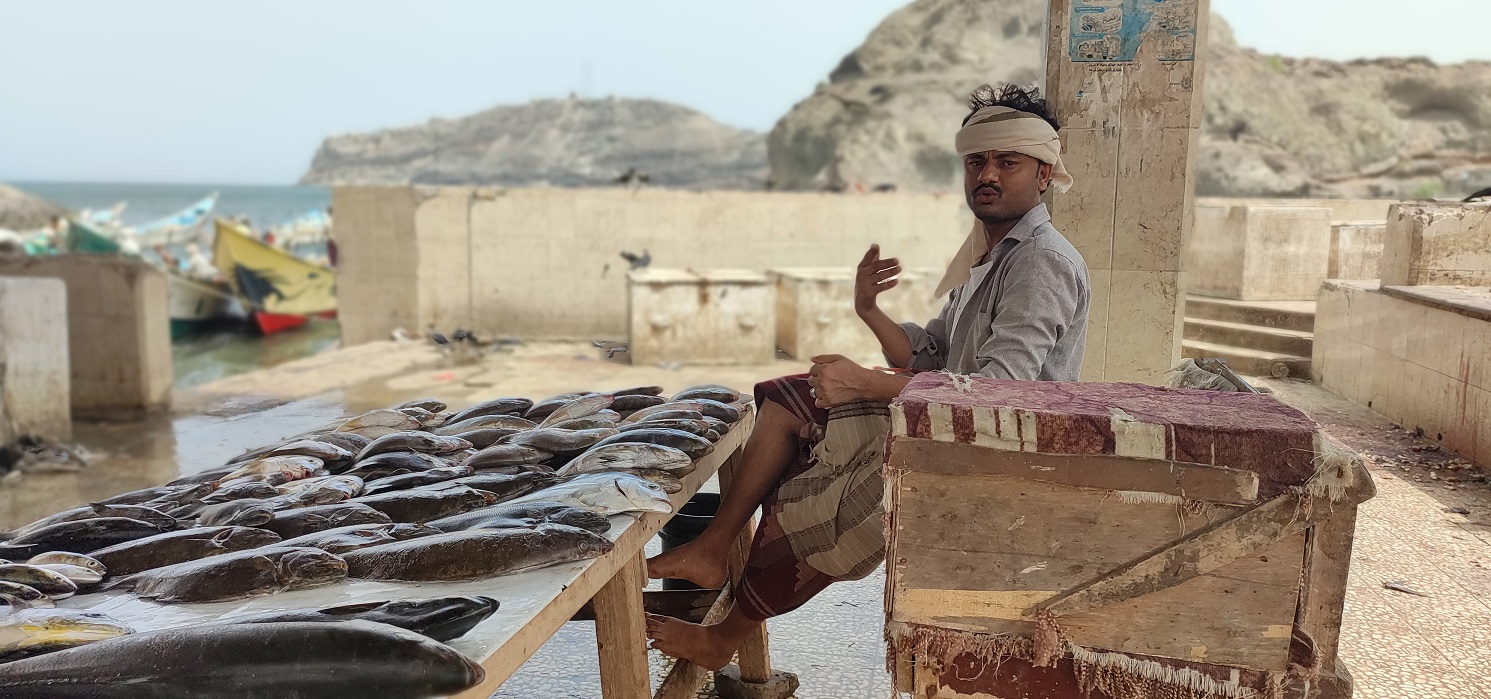
A fisherman displays fish in the Sira Fish Landing Center in Aden, August 2022 (South24 Center)
In this report, “South24 Center” document statements by government officials in addition to local experts and fishermen about illegal fishing activities in South Yemen’s territorial waters practiced by foreign and local parties for many years until today.
The report monitors what was published by the global organizations in this regard, foremost of which is Global Fishing Watch (GFW).
Marine wealth
The expert and member of the STC’s Higher Economic Commission Dr. Adel Al-Ghouri explained the scale of South Yemen’s marine wealth and the importance of the maritime fishing sector for the national economy.
Al-Ghouri told “South24 Center”: “We consider the coasts of the Gulf of Aden and the sea among the richest regarding fish and diverse marine life. This is attributed to climate and geomorphological factors which provide favorable conditions for fish breeding.”
“Water of South Yemen’s Exclusive Economic Zone (EEZ) is characterized by the big diversity of fish and marine species which include more than 500 species of pelagic fish and other marine life in addition to the seabed resources (cephalopod, crustacean, deep shrimp and deep lobster)," he added.
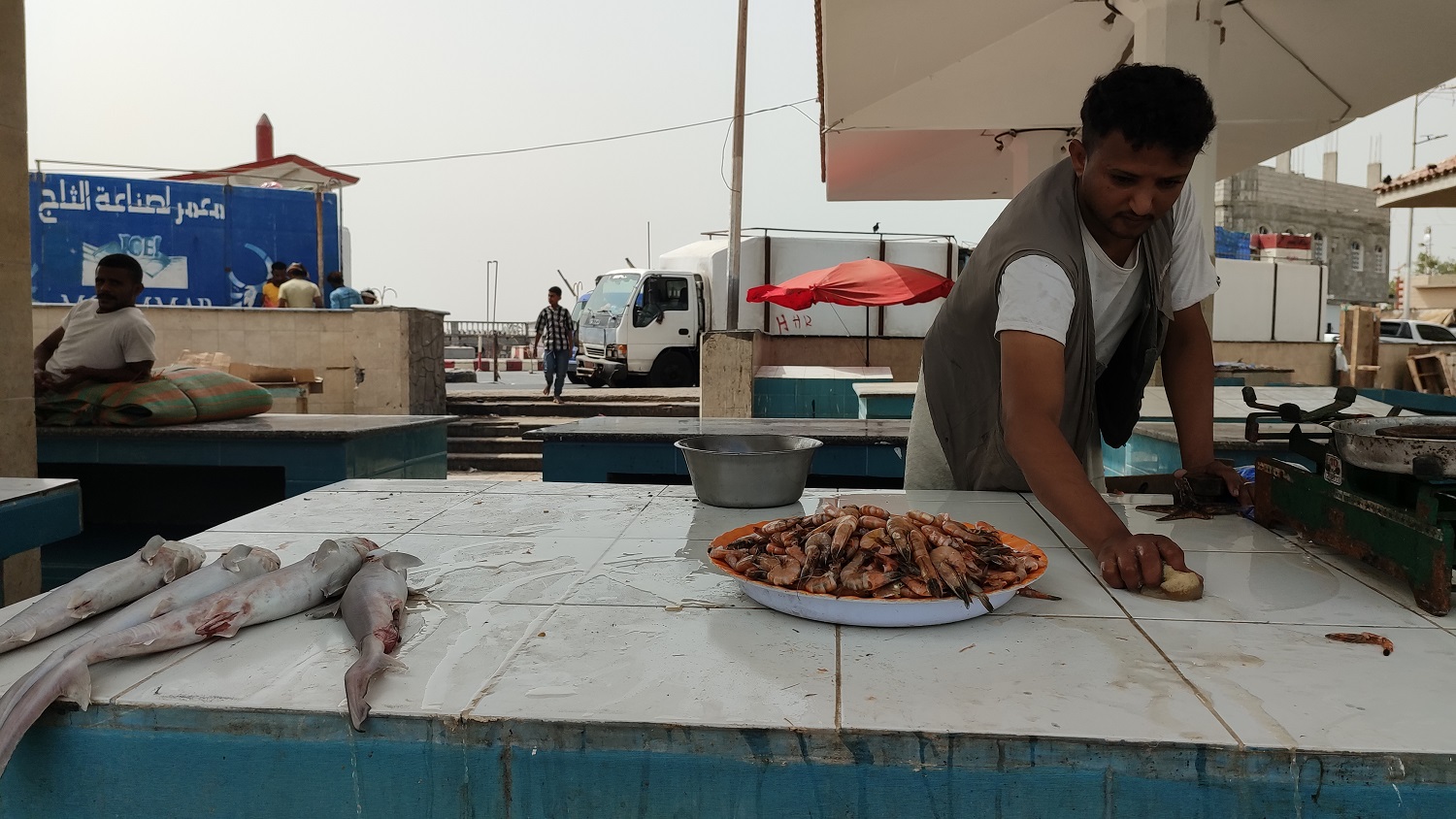
A fisherman displays fish in the Sira Fish Landing Center in Aden, August 2022 (South24 Center)
The United Nations Convention on the Law of the Sea in 1982 set exclusive economic zones up to 200 miles offshore [3]. South Yemen’s territorial waters constitute the biggest percentage of the territorial waters of Yemen as a whole.
It is estimated that Yemen’s annual sum fisheries production amounted to 200,000 tons prior to the conflict; 40-50 percent of production was sent for export, generating revenues of about US$ 300 million [4].
Overfishing
Southern fisherman Mohammed Saleh Ahmed aged 37 years old told "South24 Center" that he saw big fishing vessels in the Gulf of Aden.
He said: "I saw several foreign fishing ships and boats in the Gulf of Aden. They spread in the deep-water areas in which marine species such as (Al-Thamad) are available. We as Yemeni fishermen, have the license to operate this activity in such deep areas.”
Mohammed is one of the local fishermen registered in the “Sira Fishermen Association" in Aden who spoke to "South24 Center" in the Sira Fish Landing Center. There are similarities among the statements of these fishermen about these activities in the territorial waters in South Yemen.
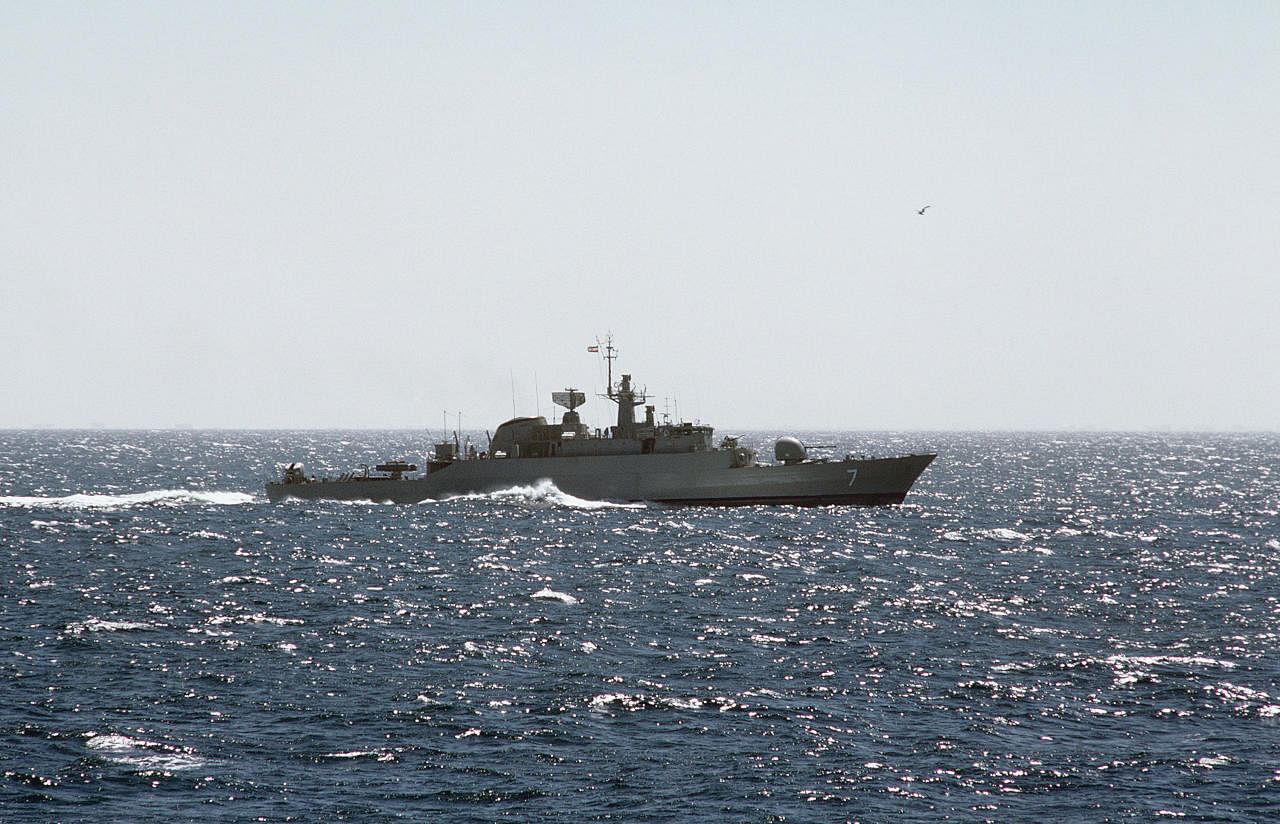
An Iranian fishing vessel in the Yemeni territorial waters, October 31th 2016 (SPA)
The fishermen determined the places of shipping vessels in the Gulf of Aden and Shuqrah coasts in Abyan as well as near Al-Mahra, the vicinity of Socotra Island, and Bab Al-Mandab.
Adel Al-Ghouri reiterated the fishermen's statements by saying: "Regarding the presence of foreign fishing vessels, we confirm that there are Iranian, Thai, Chinese and Egyptian fishing vessels that carry out illegal activities".
These vessels operate without a license from the Yemeni government according to Eng. Nael Saeed Ahmed, Director General of the Fish Ports and Landing Centers in Aden, Lahj and Abyan affiliated with the General Authority for Fisheries in the Gulf of Aden which is part of the Ministry of Fish Wealth.
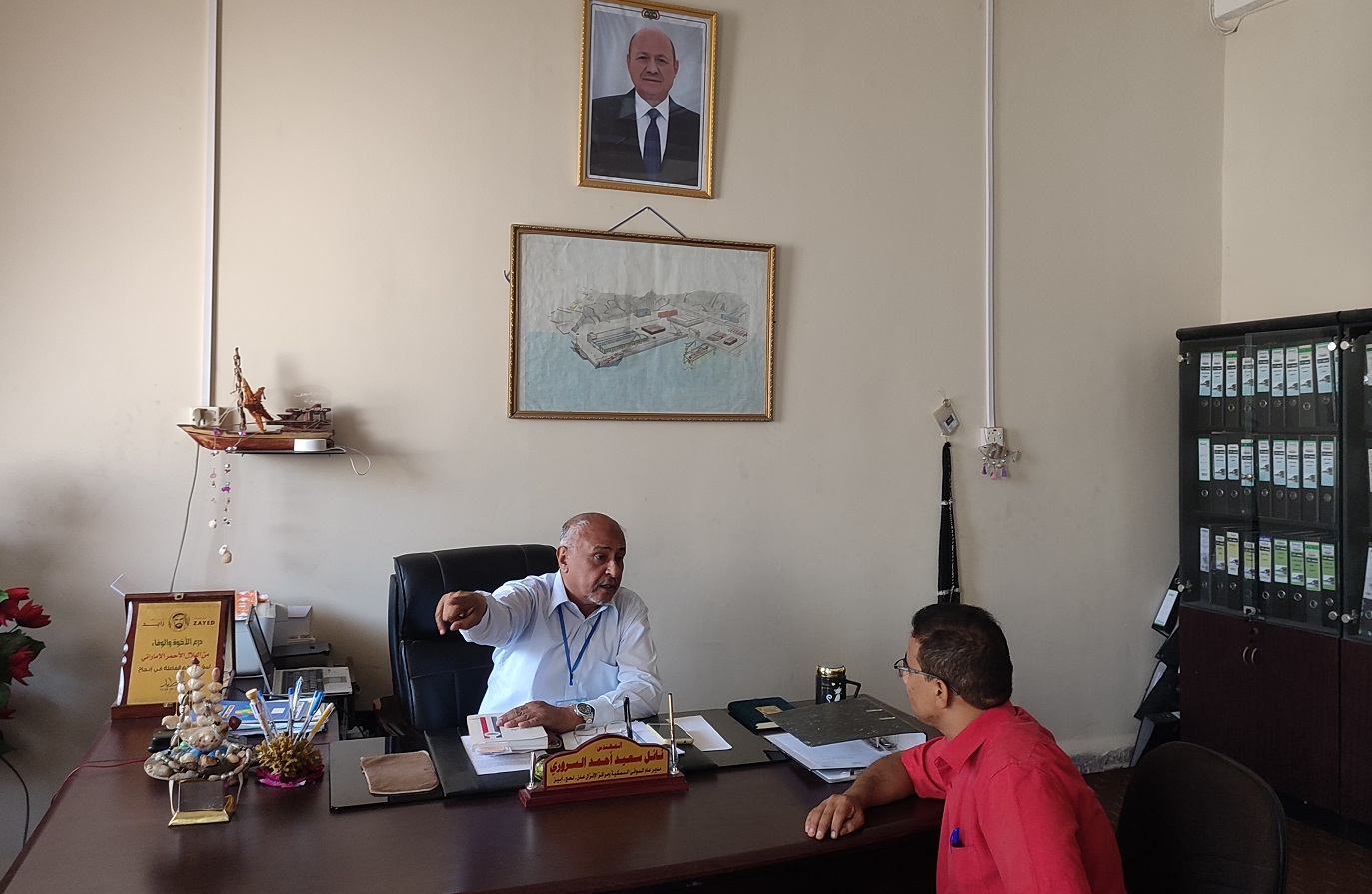
South24 Center correspondent with Eng. Nael Saeed Ahmed, Director General of the Fish Ports and Landing Centers in Aden, Lahj and Abyan of the General Authority for Fisheries in Aden Gulf which is part of the Ministry of Fish Wealth.
The governmental official told "South24 Center": "We, as the government, have not given any licenses to any foreign vessels or boats to practice fishing in the territorial waters. There have been no licensed vessels since 2014".
Exclusive sources in the Ministry of Fish Wealth told "South24 Center" that "the Yemeni government and the presidency received in 2019 several reports about illegal fishing activities but they have not taken any measures towards them”.
In June 2020, Global Fishing Watch said that “Nearly 200 Iranian vessels detected in Somali and Yemeni territorial waters between January 2019 and April 2020 practicing illegal fishing” adding that “ this may represent one of the world’s largest illegal fishing operation”. [5]
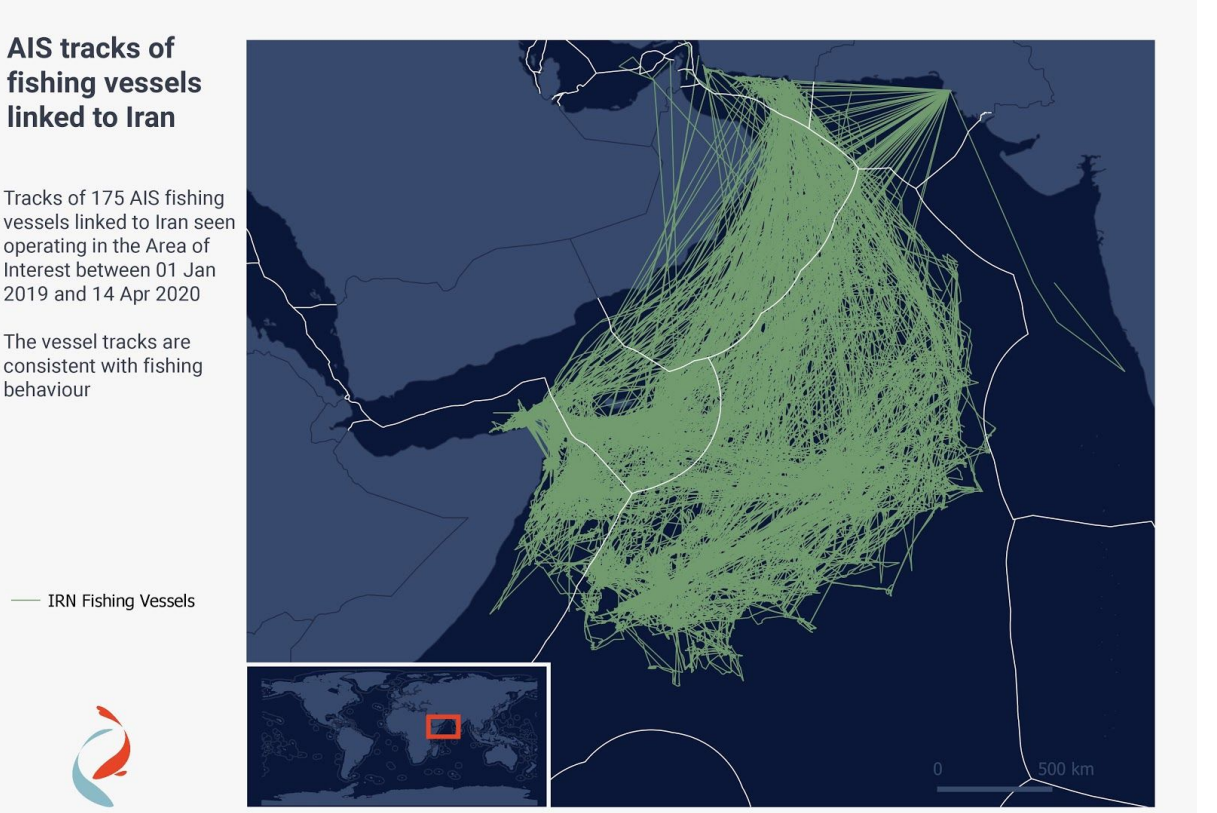
Map of the AIS tracks from 175 fishing vessels linked to Iran during the 2019-2020 fishing season. Significant activity can be seen inside the Somalia and Yemen EEZs. (GFW)
The organization added that “the scale of the problem was unknown until fishing vessels in the region recently started using automatic identification system (AIS) – a collision avoidance system that continuously transmits a vessel’s location at sea.”
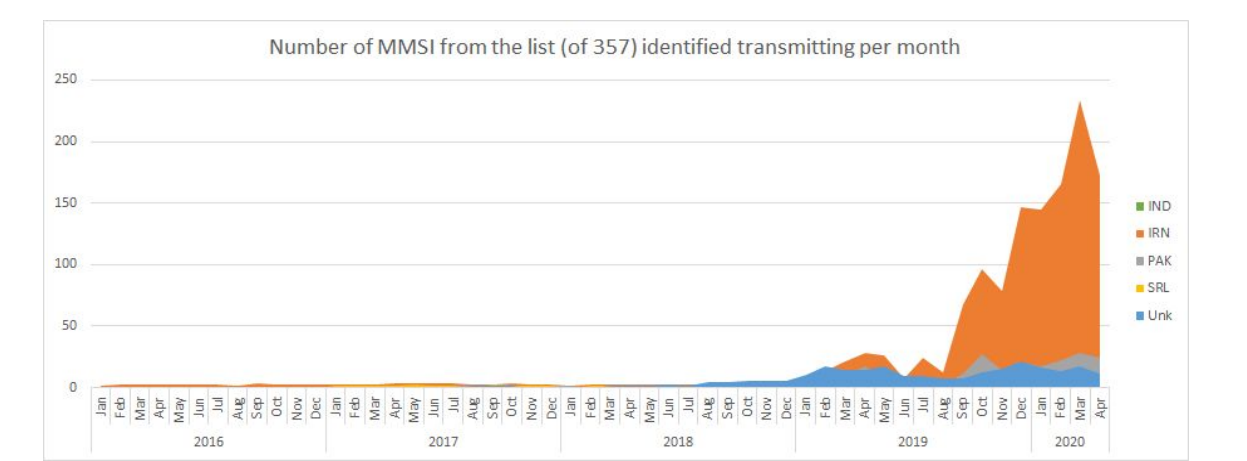
Monthly number of unique AIS-MMSI system of fishing vessels and fishing gear experience observed operating in the EEZs of Somalia and Yemen in 2019 and 2020. (GFW)
It indicated that “the analysis of this data has identified a fleet of predominantly Iranian vessels operating extensively in the Somali and Yemeni exclusive economic zones (EEZs), and on the adjacent high seas. A smaller subset of Indian, Pakistani, and Sri Lankan flagged vessels have also been identified in these areas.”
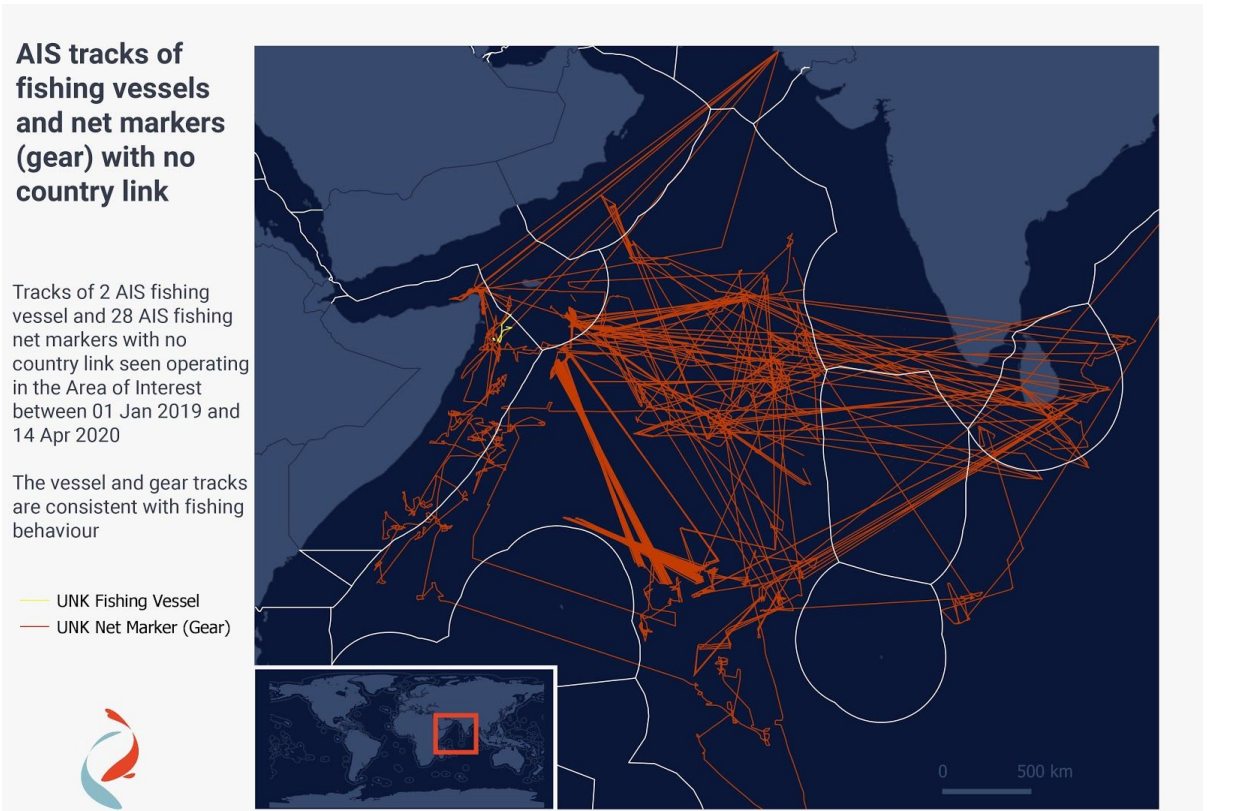
Tracks of 2 AIS fishing vessels and 28 AIS fishing net markers with no country link seen operating in the Area of interest between Jan 1, 2019 and April 14, 2020 (GFW)
In its report, “International Crisis Group” said: “Yemen’s coasts face destruction and over-exploitation as the lack of monitoring and law enforcement have increased illegal fishing practices and harassment.” [6]
Overfishing operations have not been limited to foreign parties but they also include lists of offending local fishermen.
Expert Adel Al-Ghouri attributed the reasons behind the boom in overfishing operations to the weakness of government and the absence of the General Administration of Maritime Control and Inspection affiliated with the Ministry of Fish Wealth.
Al-Ghouri said: “As far as I know, this administration has no budget. Unfortunately, it has become hard for it to do its duties. Not giving the judicial seizure to the maritime observers and inspectors has facilitated overfishing operations and fish depletion.”
He added: “Additionally, there is no operation room equipped with devices for modern communications and marine control. Furthermore, the General Administration of Maritime Control and Inspection is incapable of communicating with the general authorities of fisheries in all coastal governorates. ”
Al-Ghouri added that “there is a lack of boats equipped with navigational and communication devices to implement marine patrol operations, protect the coastal strip, combat poaching, and prevent traditional fishermen from using fishing methods outside the legal scope.”
The expert indicated that the current fishing activities violate Law no (2) issued in 2006 related to organizing fishing and protecting aquatic life. [7]
He added: “The General Administration of Maritime Control and Inspection cannot detect fishing boats and vessels in our territorial waters or even coordinate with the security bodies in the coastal guards. Unfortunately, the ministry has no international participation to monitor the coasts and territorial waters.”
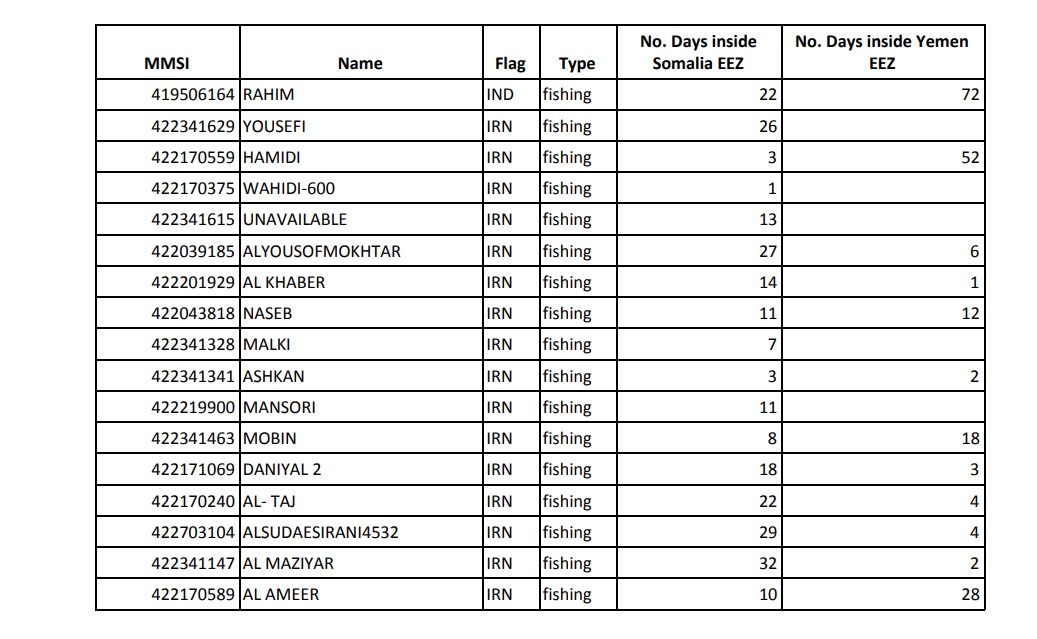
Part of the list of foreign vessels observed by the automatic identification system (AIS) operating within EEZS in Somalia and Yemen in 2019 and 2020. (GFW)
Ahmed Fadaq, Director of the General Department of Maritime Control, and Inspection at the Ministry of Fish Wealth admitted the weakness and the lack of capabilities of these important government devices.”
He told “South24 Center”: “We are considered the only governmental body which generally supervises all general authorities of the fisheries in all governorates. We suffer from a sharp lack in the financial and logistic capabilities. We just have a simple device with limited capabilities to monitor boats who officially have fishing licenses from the Yemeni authorities.”
He added: “This device is linked via satellite through which we track boats licensed by us.”
Colonel Fadl Al-Mrash, Deputy Director of the “Coast Guards” told “South24 Center” that “what happens in South Yemen’s territorial waters regarding overfishing operations has exacerbated recently”.
He added: “Years ago, there was a project to enhance the monitoring and auditing operations in the territorial waters of our country. Germany backed this by modern boats to conduct ongoing patrols, as well as plant monitoring and sensor devices in the sea, but this project has not been completed.”
The official claimed that Coast Guards chased some vessels involved in these illegal activities. He added: “When we detect a foreign vessel conducting overfishing and we try to seize our country’s territorial waters, it quickly leaves our territorial waters towards other territorial waters.”
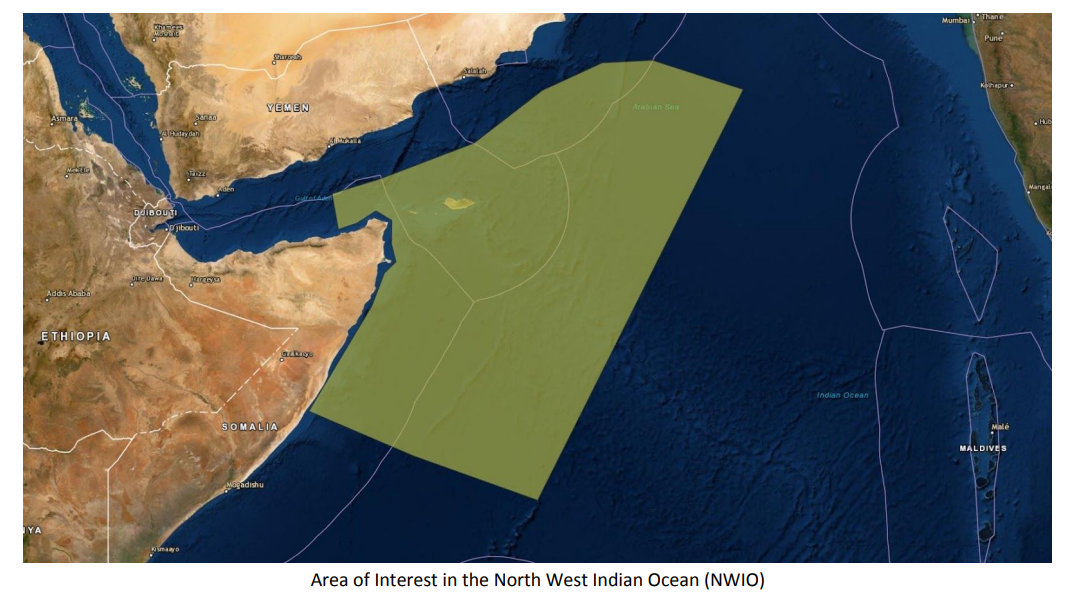
Area of interest for the GFW report regarding illegal fishing operations, in the Northwest Indian Ocean during the 2019-2020 fishing season.
He added: “This made us lose the legitimacy of seizing them or documenting a violation against them.” In January 2019, former Fish Wealth Minister Fahd Kafayen told the press that “Yemen has seized 43 Iranian ships fishing in the Yemeni waters over the last three years. [8]
Kafayen said that “the state’s monitoring on the sea has decreased due to lack of capabilities and the security situation. This allowed foreign vessels to illegally fish in the Yemeni waters.”
Impact and ramifications
Al-Ghouri said that “there are dire negative effects for illegal fishing activities in Yemen’s territorial waters starting with threatening, scraping and harming the marine environment through the serious repercussions on the national economy and food security.”
The US Department of State defines illegal fishing as being an activity that “does not respect rules adopted at either the national or international level. It threatens economic growth, food security, and ocean ecosystems around the world.” [9]
The ministry said in a report that illegal fishing “undermines sustainable fisheries and the law-abiding fishers and communities that depend on them. It also results in global losses in the tens of billions of dollars each year.”
The report pointed out that “keys to tackling illegal fishing include eliminating the economic incentives that drive it, ensuring that governments effectively monitor and control their fishing vessels, and building capacity in developing countries for fisheries management.”
In November 2018, Fahd Kafayen told Saba News Agency: “Illegal fishing in Hadramouts coasts killed tens of tons of auxis (frigate tunas) in the coasts of Mukalla over the two past days”. [10]
In November 2019, local fishermen in the city of Mukalla, the capital of the biggest Southern governorates, Hadramout, organized a protest to stop illegal fishing operations. [11]
1- Eng. Niazi Ahmed Mahdi General, Director General of Yemeni Fish Wealth Ministry
2- The same source
3- Oceans and the Law of the Sea (UN.org)
4- Developing Yemen’s Fishing Industry (Sanaa Center for Strategic Studies)
5- Illegal Fishing Hotspot Identified in Northwest Indian Ocean (GFW)
6- Perils of the SeaInternational Crisis Group
7- Law no (2) issued in 2006 related to organizing fishing and protecting aquatic life (yemen-nic.info)
8- Exploitation of Yemen’s seas is depleting country’s fish stocks, minister warns (thenationalnews)
9- Illegal, Unreported, and Unregulated Fishing (US Department of State)
11- Mukalla fisherman call for putting an end to illegal fishing (Al-Ayyam Newspaper)